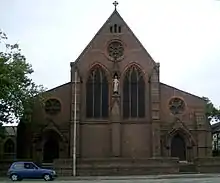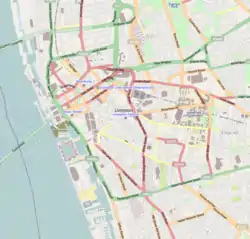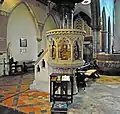Church of St Margaret of Antioch, Liverpool
The Church of St. Margaret of Antioch is in Prince's Road, Toxteth, Liverpool, England. It is an active Anglican parish church in the diocese of Liverpool, the archdeaconry of Liverpool, and the deanery of Toxteth and Wavertree.[1] The church is recorded in the National Heritage List for England as a designated Grade II* listed building.[2]
| Church of St. Margaret of Antioch, Liverpool | |
|---|---|
 West front of the church | |
 Church of St. Margaret of Antioch, Liverpool Location in Liverpool | |
| OS grid reference | SJ 359,892 |
| Location | Prince's Road, Toxteth, Liverpool |
| Country | England |
| Denomination | Anglican |
| Churchmanship | Modern Catholic |
| Website | St Margaret,Liverpool |
| History | |
| Status | Parish church |
| Founder(s) | Robert Horsfall |
| Dedication | St Margaret of Antioch |
| Architecture | |
| Functional status | Active |
| Heritage designation | Grade II* |
| Designated | 12 July 1966 |
| Architect(s) | G. E. Street |
| Architectural type | Church |
| Style | Gothic Revival (Decorated) |
| Groundbreaking | 1868 |
| Specifications | |
| Materials | Brick, stone dressings, slate roof |
| Administration | |
| Parish | St Margaret, Toxteth |
| Deanery | Toxteth and Wavertree |
| Archdeaconry | Liverpool |
| Diocese | Liverpool |
| Province | York |
| Clergy | |
| Priest(s) | The Revd Canon Bob Lewis |
History
The church was built in 1868–69 and designed by G. E. Street. It was paid for by Robert Horsfall, a local stockbroker and Anglo-Catholic. The church became "the centre of Anglo-Catholicism in 19th-century Liverpool".[3] In 1924–26 the Jesus Chapel, designed by Hubert B. Adderley, was added to the north of the church. The architectural style of the church is Decorated.[3]
Architecture
Exterior
St Margaret's is constructed in common brick, with dressings in red brick and stone, and has a slate roof. Its plan consists of a nave and chancel forming a single vessel, the nave being flanked by aisles. There is no clerestory.[2] On the roof, at the division of the nave and chancel, is a timber bellcote.[3] In the central part of the west end of the church are two three-light windows, with a buttress between them and on each side. Above the central buttress is a canopied niche containing a statue of St Margaret of Antioch. Over this is a rose window. To the sides of the central part are the aisles under lean-to roofs; each has a doorway with a rose window above. A passage leads from the north side of the church to the vicarage.[2]
Interior
Inside the church are six-bay arcades carried on marble piers with bands of alternating colours. The chancel is at a higher level, and is separated from the nave by a low marble wall with central iron gates. In the chancel are a piscina and a sedilia.[2][3] On the north side of the chancel is a two-bay arcade leading to the Jesus Chapel.[3] The font is circular, carried on six columns, and stands on a hexagonal base.[2] The pulpit is in gilded wood, and is decorated with busts of saints. In the chancel floor is a brass to Robert Horsfall. There is much painted decoration on the walls, most of it by Maddox and Pearce. Much of the stained glass is by Clayton and Bell. The glass in the west window of the south aisle is by Percy Bacon Brothers. At the east end of the church are two windows, replaced after the Second World War, which were designed by Gerald E. R. Smith and H. L. Pawle, and made in the A. K. Nicholson Studio. In the Jesus chapel is an ornate polychrome reredos.[3] The two-manual pipe organ was made in 1869 by Henry Willis.[4]
 Nave looking east
Nave looking east Pulpit
Pulpit Chancel railings
Chancel railings Altar, Lady Chapel
Altar, Lady Chapel Font
Font Stained glass window
Stained glass window
References
- Toxteth: St Margaret, Toxteth, Church of England, retrieved 14 April 2013
- Historic England, "Church of St Margaret, Liverpool (1292876)", National Heritage List for England, retrieved 14 April 2013
- Sharples, Joseph; Pollard, Richard (2004), Liverpool, Pevsner Architectural Guides, New Haven and London: Yale University Press, pp. 245–247, ISBN 0-300-10258-5
- Lancashire (Merseyside), Liverpool, St. Margaret, Princes Road, Toxteth (N01667), British Institute of Organ Studies, retrieved 14 April 2013